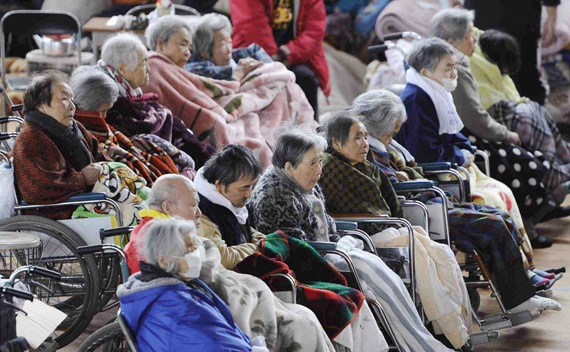Another Rocky Day for Japan
More on:

[Click here for information on how to locate friends and family in Japan, and here for how you can help]
At ten thirty in the night of March 15, another earthquake—magnitude 6.4—rocked the Kanto plain. Watching NHK to catch up on the latest news, I watched the incredibly composed news team at Newswatch 9 begin to report on an aftershock along the northeastern coast—and warn residents of the potential for a tsunami.
But then the studio began to rock, and they began to realize that they were in the midst of another earthquake, centered this time just south of Tokyo. Cameras revealed the powerful lateral swaying buildings of Yokohama, Shizuoka and Tokyo.
Just another night in a country that is struggling to cope with a national emergency that includes unimaginable devastation in the northeastern coast, a nuclear emergency at the tsunami-ravaged Fukushima Daiichi plant, and an economy that is reeling. As information about explosions in the nuclear plant raised fears and anxiety, the Nikkei lost more than 1,000 points—a 10 percent loss in Japan’s assets.
All day today the urgent need for assistance at evacuation shelters in the north was communicated to national TV viewers. Messages from those in shelters, over 80 percent of who are elderly, ask for water, food, blankets and medicine. Local officials urged the national government to step up their efforts as they worry about the evacuees’ failing health, and the potential for more serious outbreaks of disease.
Meanwhile, Self Defense Force search and rescue teams, accompanied by local residents, continue their grim task of searching the rubble of communities devastated by the tsunami. The television coverage on Tuesday, day four, continued the telling of individual stories. The horror of the day continues to be recalled. Amidst the sadness of those who face mountains of debris in their search for family and friends, there are moments of relief as those stranded in buildings were rescued and given access to telephones to reach their family.
In tsunami-stricken Iwate, today, there were signs of help arriving. A British search and rescue team with their dogs arrived to begin their work amidst the crumpled buildings and impenetrable piles of ruin left behind by the tsunami. A doctor began to talk to a group at an evacuation center. When he asks the elderly evacuees if anything is bothering them, many hesitate and then raise their hands: “we cannot sleep, we are so frightened.” The doctor reassures them that he has medicine that will help them. In a gymnasium-turned-shelter, middle and high school students put up a brightly colored, hand painted sign: “We have our lives—let’s try hard to be happy!”
While everyone is safe, life in Tokyo is wearing. The rolling blackouts have created confusion. Traffic signals are not working; refrigeration is compromised. Consumers have cleared shelves of goods that can be sustained over time. Noodles, rice, and other basic foodstuffs are being stockpiled, creating difficulties for supermarket inventory. The transportation system has had to improvise, and many companies, including Mitsubishi Truck, Sony, and Rakuten, have told their employees to work from home rather than wait in line for hours to get on a train.
The news broadcasters are now reporting minimal damage from the new quake. Power lines are down in some areas, but traffic continues along the major highways connecting Tokyo to the south and west as supplies continue to flow north. Meanwhile, the weather man reports snow and freezing rain in the stricken prefectures in Tohoku.
More on:
 Online Store
Online Store